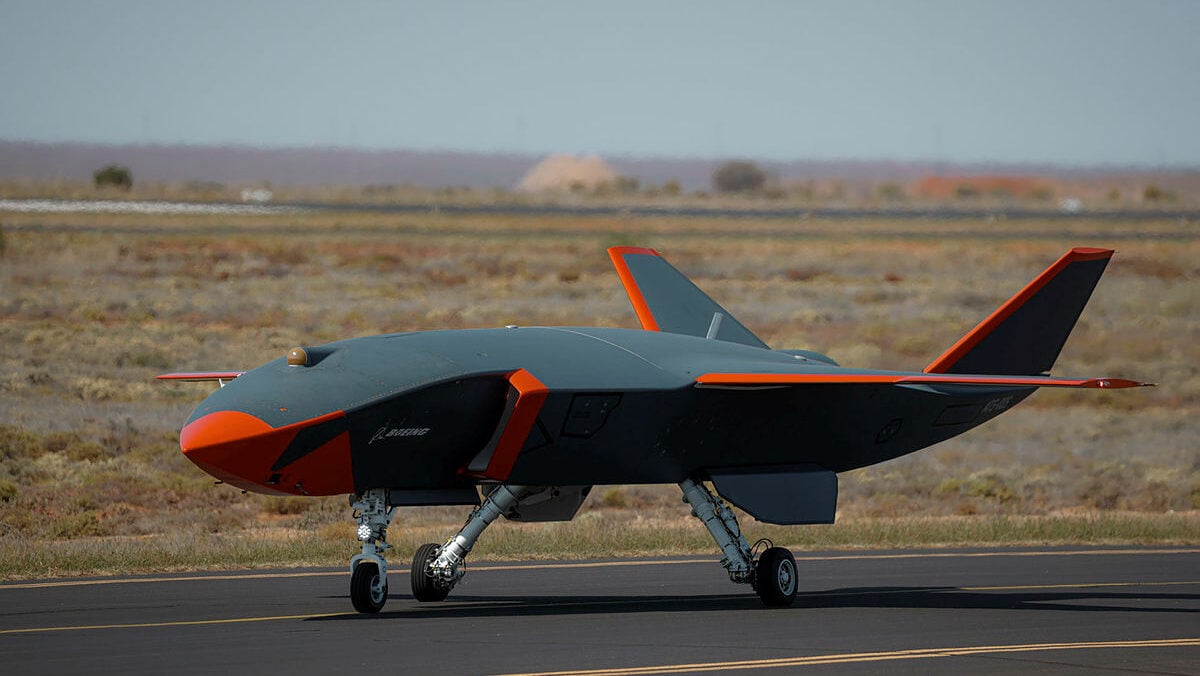
Australia’s MQ-28 Ghost Bat is expected to undergo crewed and uncrewed teaming testing, for the first time, next year (Photo: Australia DoD)
CANBERRA — Australia will begin testing the Ghost Bat, the first aircraft designed and built here in the last 50 years, for its real mission of “crewed and uncrewed teaming” in 2025, the chief of the Royal Australian Air Force said today.
Air Marshal Robert Chipman, speaking at the annual Air & Space Conference, said the Boeing-built MQ-28 Ghost Bat, “will demonstrate the potential of crewed and uncrewed teaming to improve the survivability and lethality of our air combat system in an operationally relevant scenario.”
The Albanese government recently announced $400 million AUD to deliver three additional Block 2 versions with enhanced design and improved capability to add to the original eight aircraft. “The new aircraft will allow further testing and development of key aspects of CCA capabilities and how they work with crewed platforms in operational environments,” the statement said at the time.
Chipman cast the Ghost Bat testing as part of the Air Force’s efforts to do more with the flat budget handed to it when the National Defense Strategy and the concomitant Integrated Investment Program were recently announced.
He pointed to Australia’s parallel Air6500 investment in a command and control system for integrated air and missile defense as an example of what the RAAF could do with existing assets. “When integrated effectively with ground-based and maritime missile systems, we can achieve much with our existing platforms, even as we recognize the need to grow this system in response to a rapidly evolving threat environment,” Chipman said in his opening speech to the conference.
He also appeared to remind Defense Minister Richard Marles and the treasurer of the Albanese government that the Air Force is under pressure in spite of having “undergone major recapitalization in recent years.”
He said the service is “still at risk of capability stagflation, low preparedness, workforce hollowness and ongoing budget pressure.”
Malcolm Davis, a defense expert at the Australian Strategic Policy Institute, said Chipman was “sending a less than subtle message to the treasury and to Marles that you need to maintain momentum of fleet completiveness in the Air Force.”
If the Air Force “doesn’t have sustained spending on defense then we won’t be available to develop these new capabilities and we won’t have sufficient mass,” added Davis. He noted that “it’s undeniable that the Air Force did take a cut to pay,” mentioning in particular the “loss of a squadron of F-35s and the plan to keep (F-18) Growlers longer” while the Navy gets AUKUS submarines and will double the size of its surface fleet.
The service’s biggest capability risk right now, Chipman said, is maintaining its workforce.
“Our first challenge is to strengthen our workforce, more specifically to address the shortfalls in those specific masteries and experience levels that constrain our capacity to grow. We are finding inefficiency and obstruction throughout our people system in recruiting and retention in training and professional development,” he said, pointing to the slow and complex process of hiring and processing new airmen.
“Our experience has been that the interventions required to improve workforce health operate over a very long lifecycle, demanding farsighted workforce intelligence and long term strategies. Our challenge is to find a way to shorten that lifecycle for our workforce interventions.”
Joining Chipman on stage, Lt. Gen. John Frewen, whose principal title is Chief of Joint Capabilities, said he’d been asked to speak in a different capacity — one which could be a low-key announcement of a new shift within the Defence Department.
“Many of you will know me as the chief of joint capabilities, which is my primary, overarching role. As chief of joint capabilities, though I have two key responsibilities. The first is a functional role delivering the logistics support and sustainment to the entire ADF across the national support base. The second is a domain role. And in this I lead on the force generation of ADF capabilities in the space and cyber domains in a similar way to what the service chiefs do in the maritime, land and air domains,” Frewen said.
“We’ve now grouped all space inside the entities within joint capabilities group to achieve his ends. And it is in this capacity as the lead for the space and cyber domains as the chief of space and cyber force that the CDF (Chief of the Defense Force) asked me to speak to you today.”
Davis speculated that Frewen’s statement could indicate plans to create a “Royal Australian Space Force,” which would effectively be a new service, similar to the US Space Force.
No other details were offered and neither Frewen nor Chipman took any questions.






















